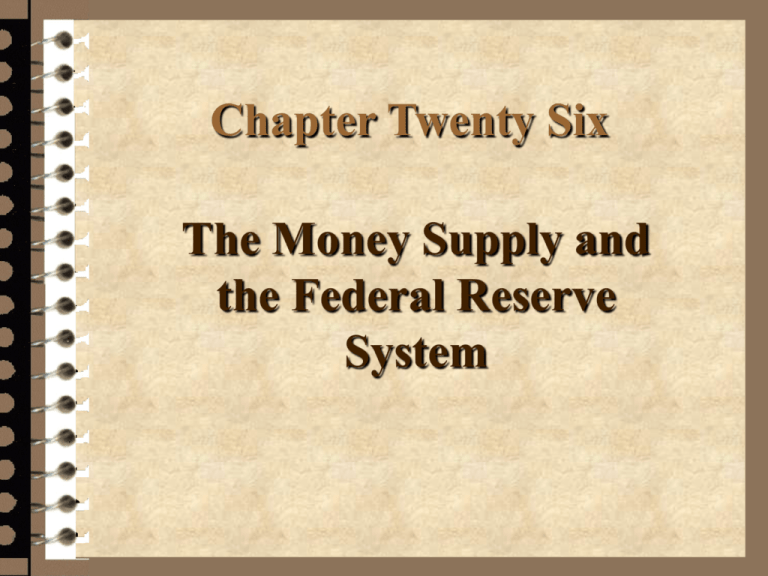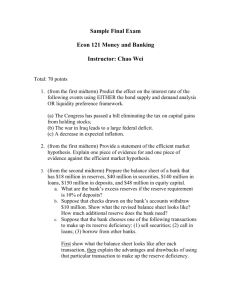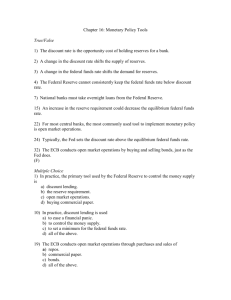National Income Determination - The Fed and the Supply of Money
advertisement

Chapter Twenty Six The Money Supply and the Federal Reserve System What is Money? Medium of exchange Store of value Unit of Account Liquidity property of money Forms of Money Commodity money Convertible paper money Fiat money Legal tender Money -- Official Definitions M1 –Currency held outside banks, plus Demand Deposits and other checkable deposits, plus Traveler’s Checks, etc. M2 –M1 plus Savings Deposits, plus Money Market Accounts, etc. Components of M1 - Transactions Money Currency (held outside of banks) Demand Deposits Traveler’s checks Other checkable deposits M1 Currency Components of M1 Demand Deposits Other 1200.0 1000.0 Dollars 800.0 600.0 400.0 200.0 0.0 1963 1967 1971 1975 1979 Year 1983 1987 1991 Components of M1 Components of M1, 1980 Components of M1, 1994 Demand Deposits Currency Other As definition of money becomes broader, less liquid assets are added. Liquid Asset: an asset which can be easily converted into a means of payment at a predictable price Growth of M1 and M2 Reserve Requirements Reserves: The amount of funds which a member bank must legally keep on deposit with the Federal Reserve or in its vault as cash. Based on the total deposits of the bank, a fixed percentage of deposits must be held as reserves. Reserves Required reserve ratio: The percentage of its total deposits that a bank must keep at the Federal Reserve…that amount is called the bank’s required reserves. Excess reserves: The difference between a bank’s actual reserves and its required reserves. Reserves Example Suppose the reserve ratio is 20% You deposit $20,000 into your checking account Money Supply = $20,000 Bank $20,000 What happens to the deposit? $4,000 stays at the bank as reserves $16,000 is available for loans Your friend borrows $16,000 for a new car Bank $20,000 Loans = $16,000 Reserves = $4,000 Banks Creating Money The money supply is now equal to $36,000 -- $20,000 plus $16,000 -- what you deposited plus what your friend has borrowed. The loan created money. Money Supply = $36,000 Banks Creating Money Suppose your friend deposits the $16,000 in a bank... Bank $16,000 The bank must hold 20% as reserves ($3,200), and lends out the rest... Bank $16,000 Loans = $12,800 Reserves = $3,200 The money supply is now equal to $48,800 -- $20,000 plus $16,000 plus $12,800-- what you deposited plus what your friend has borrowed plus the final loan. The loan created money. How much money can be created from a $20,000 deposit? Total Money = $20,000/0.2 = $100,000 This is the maximum amount of money that can be created. Total Money = $20,000/0.2 = $100,000 Money Multiplier Multiple by which deposits increase for every dollar increase in reserves Money Multiplier = 1/required reserve ratio Money Multiplier The money multiplier might be smaller because… Banks hold excess reserves Households don’t deposit all of their cash holdings Federal Reserve System Board of Governors Alan Greenspan, Chair, Federal Reserve Board Federal Reserve System FOMC Board of Governors 12 Federal Reserve Banks National Banking System: Commercial Banks, Savings and Loans, Credit Unions The 12 Federal Reserve Banks Functions of the Fed Control the money supply Clear interbank payments Lender of last resort Monetary Policy An attempt to alter the economy by changing the money supply Controlled by the Fed –FOMC: Federal Open Market Committee How the Fed Controls the Money Supply Tools of Monetary Policy Required Reserve Ratio Discount Rate Open Market Operations Reserve Requirements Required reserves: the percentage of deposits banks must hold in cash or on deposit with the Fed Decreasing the reserve ratio increases the money supply Increasing the reserve ratio decreases the money supply Discount Rate The interest rate at which the Fed lends reserves to member banks Increase in the discount rate decreases the supply of money Decrease in the discount rate increases the supply of money Open Market Operations (OMO) Open market operations refers to the buying and selling of government bonds in order to change the supply of money. Government Bonds: The debt of the federal government. Sold in various maturities. Selling Bonds If the Fed sells a bond, the money supply decreases by the price of the bond. Purchasing Bonds If the Fed purchases bonds in the open market this increases the money supply by the price of the bonds. Money Market Interest Rate 15% 10% Ms Real Money Supply 5% Quantity of Real Money Review Terms & Concepts Barter Fiat, or token money Commodity monies Financial intermediaries Currency debasement Legal tender Discount rate Lender of last resort Excess reserves Liquidity property of Federal Open Market money M1 (transactions money) M2 (broad money) Medium of exchange Committee (FOMC) Federal Reserve System (Fed) Review Terms & Concepts (cont.) Money multiplier Reserves Moral suasion Run on a bank Near monies Store of value Open Market Desk Unit of account Open market operations Required reserve ratio








